Best Delay Reverb Pedal Combos 2023 - Two Effects in One
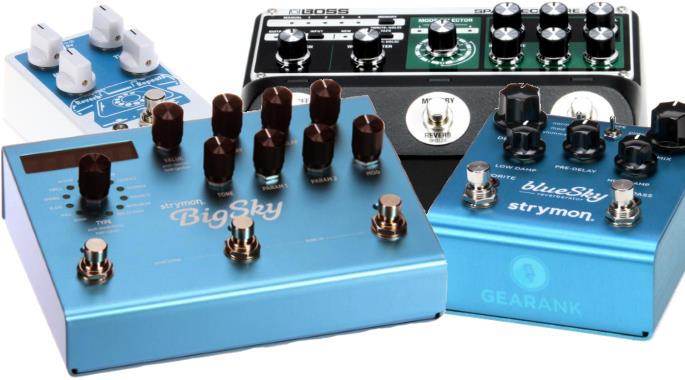
The Best Delay Reverb Combo Pedals
EarthQuaker Devices Dispatch Master V3 Digital
Cons
- Not for those who want to tweak
- Limited reverb features
- No tap tempo for the delay section
Pros
- Quality Reverb + Delay in one pedal
- Dense and natural-sounding reverb
- Organic sounding delay repeats
- Streamlined and efficient controls
The Dispatch Master V3 is a delay reverb pedal with a straightforward set of controls. It has four knobs and a single footswitch. The controls let you switch between reverb only mode or delay only mode. And you can blend both at the same time by simply turning the reverb and repeat knobs up or down.
The main advantage of V3 over its predecessors is the inclusion of flexi-switch technology. It allows for silent and on-off switching and momentary switching (hold the switch for on, let the switch go to run off). The input and output jacks are also now positioned at the top.
The reverb section has two dedicated knobs, mix, and reverb, so there's no need to deal with multiple parameters. The mix knob is self-explanatory. The reverb knob goes from basic room to ambient shimmer. Both knobs are enough to cover the typical needs of guitarists.
Even with just these two knobs, it sounds dense and natural. And it doesn't take anything away from your core sound. The reverb section also doesn't fight or override the pedal's built-in delay. This simplicity is what makes the Dispatch Master a crowd favorite, but it also makes it unsuitable for those who want more control. This means that features like tap tempo are excluded.
The delay section has two knobs for adjusting time and repeats. It has organic-sounding repeats that sounds more natural than many standalone digital delay effects. It works great with clean or overdriven tone, and blends nicely with the reverb. All in all, the pedal's four knobs provide are effective and provides essential controls. Because the delay has more of a "smearing" effect than full fidelity repeats, the absence of a tap tempo might not be a necessity.
Build quality is up to par with what you'd expect from a regular-size stompbox. The top-mounted jacks are a good change, allowing for better pedalboard positioning.
This is a great choice for those who want an easy-to-use, plug-and-play, and multi-function Time based effects pedal.
Specifications
- Reverb: 1 Reverb Algorithm
- Delay: Up to 1.5 Sec Delay
- Controls: Mix, Reverb, Time, Repeats
- Input: 1 x 1/4"
- Output: 1 x 1/4"
- Power: 9V DC Power Supply (Sold Separately)
- Bypass Type: True
- Dimensions (HxWxD): 2.25" x 2.5" x 4.75"
- Weight: 1.1 lbs
| Website | Source | *Rating Value |
| YouTube | ThePedalZone | 96/100 |
| YouTube | Music Bliss Malaysia | 97/100 |
Boss RE-202 Space Echo Pedal
Cons
- No instant reverb type switching
- Complex parameters and controls
Pros
- Genuine sounding Tape delay with tap tempo
- Great sounding reverb
- Tweakable preamp saturation
- Lets you set "Wow & Flutter"
- Switchable tape age (new or old)
The Boss RE-202 Space Echo is a modern recreation of the iconic Roland RE-201 Space Echo.
Instead of using actual tape, like old tape delays, it uses digital modeling and algorithms. This allows it to recreate the "wow and flutter" of the original. along with its other characteristics like preamp flavor, saturation, and Spring Reverb Effects.
It is essentially a vintage-flavored tape delay effect that you can use without unwanted "tape hiss". It also frees you from the hassle of maintaining an actual tape machine analog delay unit. Because of their analog flavor, they can be used to produce warm sounding ambiance.
For example, the RE-202 can be set up for fast slapback style Echo. This old-school delay reverb ambiance is great for rockabilly, country, rock, and similar styles.
More importantly, the tape delay effect works in conjunction with the built-in spring reverb. This mimics the original, but with modern stereo output, courtesy of its digital delay design. In addition to the classic spring, other reverb effect types are available. You can choose from hall, plate, room, and ambience presets. Switching types is more of a hidden feature though, so it's not something you can do instantly, which is a bit of a letdown.
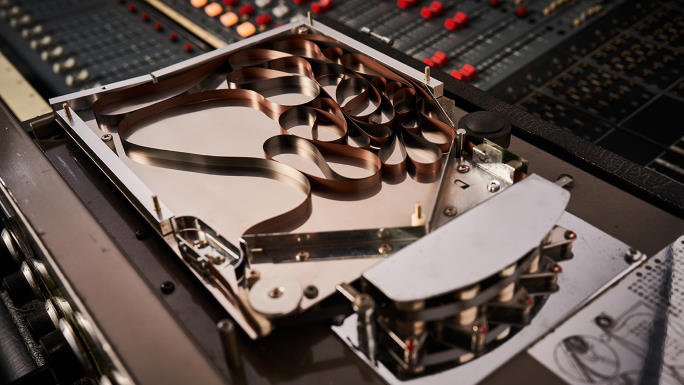
Here's a look at the innards of the original Roland RE-201
Like the original, it comes with the iconic 12-position mode selector that gives you 12 different types of echo rhythms. It also has a Repeat Rate knob which lets you adjust tape speed, it changes the echo pitch as you tweak the knob, behaving like a real tape machine.
The Intensity knob lets you set the number of echoes, and can even self-oscillate when set high enough. The Saturation knob lets you add in the analog preamp flavor of the old RE-201.
What makes this pedal closest to an old tape machine is the Wow & Flutter knob. It lets you add tape speed variations that occur within tape machines. This results in subtly modulated reverb that sounds musical and organic.
It's not a strict clone though because it features enhancements like having a fourth virtual tape head, double the delay time, and more. The Tape button is one of its coolest features. It lets you choose between new and old tape sounds, which affects the overall sound quality, tone, and wavering of the echoes.
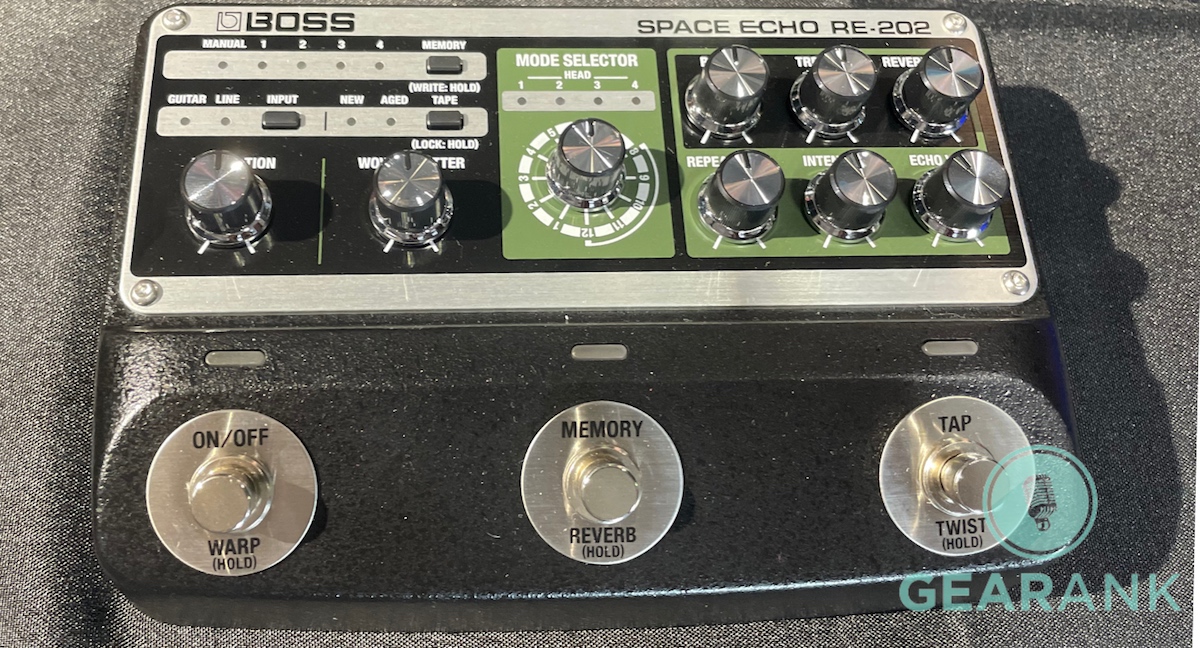
The aged tape setting gets the classic tape echo vibe down nicely, which works great for guitars and other sound sources. Speaking of sound sources, the unit has an input button that switches between guitar and line-level input. Other modern features include preset management (4 onboard memory locations, expandable via MIDI), Tap tempo, and switchable delay trail.
Having been made by Boss, you can be sure that this is a high quality pedal that will last you a long time. This versatile ambiance producing pedal is worth looking at if you're into classic tape delay and reverb effects pedals.
Specifications
- Reverb: 5 Reverb Modes, 12 Tape Modes
- Delay: Up to 2 Sec Delay
- Controls: Saturation, Wow & Flutter, Mode Selector, Bass, Treble, Reverb, Repeat Rate, Intensity, Echo Vol, Memory, Input, Tape, 3 Foot Switches
- Input: 2 x 1/4" (A/mono, B)
- Output: 2 x 1/4" (A/mono, B), 1 x 1/4" (control/expression)
- Power: Power Supply (Included)
- Bypass Type: True
- Dimensions (HxWxD): 2.04" x 7.55" x 5.23"
- Weight: 1.89 lbs
| Website | Source | *Rating Value |
| Sound on Sound | Paul White | 96/100 |
| Guitar World | Trevor Curwen | 90/100 |
| YouTube | Pete Thorn | 95/100 |
The Best Reverb Pedals
Walrus Audio Fathom Multi-Function Reverb
Cons
- Steep learning curve
Pros
- 4 reverb algorithms in one unit
- Lush and full sounding
- Allows for deep tweaking of parameters
- Works great for both clean and overdriven tone
The Walrus Audio Fathom packs 4 reverb effect algorithms in one unit. Most notable of which is the Lo-Fi mode, a filtered reverb with control over filter width.
The Sonar mode adds low and high octaves with blend control. This results in unique textures that are not found in conventional reverb pedals. It also has traditional modes which include Plate and Hall, both of which allow for pre-delay time adjustments.
In addition to these modes, it gives you deep control over parameters. There are so many ways to shape the reverb response and blend it to the dry signal to taste.
The Walrus Audio Fathom sounds more premium than it actually is. It sounds lush and full, and works great for both clean and overdrive use.
Another cool feature of this pedal is its switchable trails mode, via the left footswitch. This lets you cut off the reverb tail instantly when you bypass the pedal. The other footswitch lets you control sustain and play over the trails. With its two footswitches, you can hold a chord and let it ring out while playing other parts.
All these features add up to make the Walrus Audio Fathom a versatile reverb pedal. It is capable of everything from subtle to ethereal ambience. Note that it will take a bit of time to master the controls, but learning them will let you make the most out of this pedal.
Build quality wise, there's not much to complain about. And it also helps that it has a distinct look that makes it easily stand out. For the price, you're getting quality that rivals more expensive pedals. And this is why we consider the Fathom as the best budget reverb pedal.
If you're looking for a reverb pedal that can go from traditional hall and plate to complex controlled ambience, then this is for you.
Specifications
- 4 Reverb Algorithms: Hall, Plate, Lo-Fi, Sonar
- Controls: Decay, Dampen, Mix, X, Mod (Switch), Program, 2 x Footswitches (Bypass & Sustain)
- Input: Stereo 1/4"
- Output: Stereo 1/4"
- Power: 9V DC 100mA Power Supply (Sold Separately)
- Bypass Type: Smart Bypass (Trails On or Off)
- Dimensions (HxWxD): 1.39" x 2.6" x 4.77"
- Weight: 0.79 lb
| Website | Source | *Rating Value |
| Guitar.com | Michael Watts | 90/100 |
Strymon blueSky Reverberator
Cons
- A bit pricey for its feature set
- Bulky and heavy
Pros
- Expansive echoes via shimmer mode
- Three reverb types
- Premium build quality
- Great for use with clean tone
The Strymon blueSky pedal is the smaller and more affordable sibling of the popular Bigsky. And like its big brother, it is doing very well in the market with its highly tweakable and expansive reverb effects.
Speaking of tweakable, it features three modes, plate, room, and spring. And it has a variety of controls for personalizing your reverb sound. It has high and low damping, dry/wet mix, decay, pre delay, mix, and dedicated switches for modes and reverb type.
What makes the Strymon blueSky special though is its mode switch. This lets you add modulation or shimmer to the echoes. And this in turn makes the resulting sound larger than life. And it does so without compromising clarity and sonic integrity. It sounds great when used with clean tone, but it adds a bit of mud when used on an overdriven signal. The Shimmer mode emphasizes the highs of the sonic reflections, which results in expansive echoes.
While it does sound good, the features it provides are still limited given its price tag. It's also quite bulky for a reverb pedal with three modes. Still, it's hard to deny its premium build quality, everything about it feels solid.
If price and space are not an issue, then the Strymon blueSky's boutique quality sound is definitely worth taking a closer look.
Specifications
- Three Reverb Types: Plate, Hall, Spring
- Controls: Decay, Pre-Delay, Mix, High Damping, Low Damping, Mode (Norm/Mod/ Shimmer) switch and Type (Room/Plate/Spring) switch
- Input: Stereo (2 x 1/4")
- Output: Stereo (2 x 1/4")
- Power: 9V DC 250mA power supply
- Bypass Type: True Bypass
- Other: SHARC DSP
- Dimensions (HxWxD): 4" x 4.5"
- Weight: 1.19 lbs
| Website | Source | *Rating Value |
| YouTube | Devan Bishop | 94/100 |
Strymon BigSky
Cons
- Steeper learning curve
- Bulky and heavy
Pros
- Huge and spacious reverbs
- 12 reverb types
- Deep control with preset management
- Allows for more experimental and creative use of reverb
The California-based boutique pedal builder Strymon is known for top-quality effects. And the BigSky Multidimensional Reverb is one of their most sought-after products.
The high ratings that BigSky receives further establish Strymon's dominance. From recording artists to church musicians, there is so much hype surrounding the brand.
With 12 reverb types to choose from, you have a wealth of virtual space options for your guitar signal. And it gives you expanded control options for deep customization. It does all this while keeping sound quality high, much like having a premium studio rack reverb, but in pedal format.
All the reverb types sound impressive to my ears. But my favorites are the Hall, Cloud, Shimmer, and Chorale. They add impressive space while maintaining a clear sound.
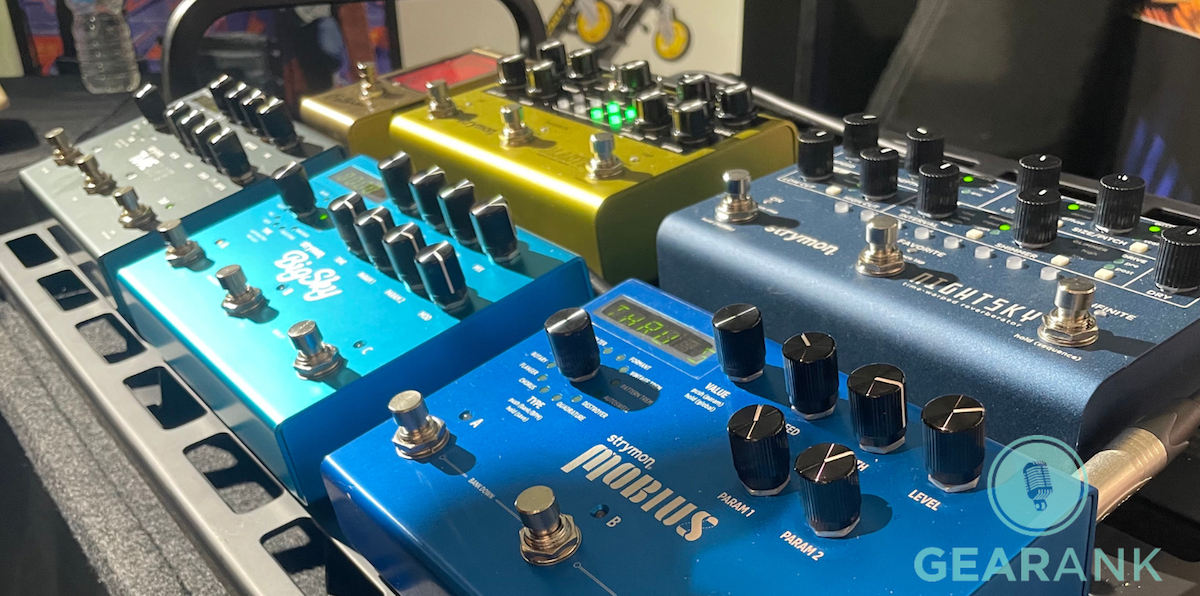
The controls allow you to fine-tune the echoes in a detailed way. Some of the knobs even function differently depending on the mode you are using.
The pre-delay knob in particular is useful for pushing the echoes a bit later. This prevents your guitar signal from getting drowned out. The mod knob lets you add modulation effect to the reflection, which makes the echoes sound bigger and wider. It also has three footswitches that give you hands-free control over presets.
The downside to all these features is its steeper learning curve. But if you really want to make the most out of this expensive pedal, then you need to take learning the parameters seriously. Other features that make this pedal a true professional's favorite include advanced input/output options, 300 customizable presets, noise-free operation, and MIDI compatibility.
This pedal has a long list of professional artist users including Dweezil Zappa, Dave Kilminster, Tom Quayle, and many more. The Strymon BigSky was consistently the Best Guitar Reverb Pedal for 2022. And looking at recent reviews, I won't be surprised if it retains the top spot throughout this year.
If you're looking for a top-shelf time based effect pedal that can double as your studio reverb rack, then get the Strymon BigSky.
Specifications
- 12 Reverb Types: Room, Hall, Plate, Spring, Swell, Bloom, Cloud, Chorale, Shimmer, Magneto, Nonlinear, Reflections
- Controls: Value, Decay, Pre-Delay, Mix, Tone, Param1, Param2, Mod, Type
- Input: Stereo 1/4", Expression Pedal
- Output: Stereo 1/4"
- Power: 9V center-negative DC 300mA Power Supply
- Bypass Type: Configurable to True Bypass or Buffered
- Presets: 300 customizable
- MIDI: MIDI Controllable
- Other: SHARC DSP
- Dimensions (HxWxD): 6.75" x 5.1"
- Weight: 0.66 lbs
| Website | Source | *Rating Value |
| Sound On Sound | Ingmar Kiang | 98/100 |
| MusicRadar | Michael Brown | 90/100 |
Things to Consider When Buying a Reverb Delay Pedal Combo
-
If you want to add ambience and space to your guitar sound, then you need Reverb. Delay pedals are for adding rhythmic echoes to your rhythm or lead playing, as popularized by The Edge of U2. Together, reverb vs delay can let you create a wide range of sounds, from subtle and ambient to psychedelic soundscapes. Note that most Guitar Amps come with built-in reverb, but they don't offer the same versatility or quality as standalone pedals.
-
Digital Sound Processing and Convolution technology have allowed us to better replicate the ambiance of actual physical rooms. Now we can even modify spatial parameters and even create our own rooms. Below are the most common reverb types along with a feature on special types that don't fall under the four main types.
-
Room
As the name suggests, it replicates the quick sonic bounces of a regular room. It has early reflections and quick decay of no more than a second. Room reverb is the most discrete of the lot, so it is often used for adding subtle warmth and sonic realism.
-
Hall
Hall reverbs are usually based on the actual acoustic space of a large music hall, only digitized for use with your pedal. Since the virtual space is bigger, the decay is usually longer, ranging from 1 to 3 seconds. It is usually employed to give the guitar sound a three dimensional ambience to emphasize certain parts. especially in rock music.
-
Plate
The plate reverb mode found on the best guitar pedals is a digital simulation of an analog plate reverb which was widely used in the past. It works by sending your guitar signal to a virtual metal plate that vibrates to create reflections and echoes that are usually very quick and full. This reverb type tends to be brighter and is commonly used for subtle enhancement.
-
Spring
Like plate mode, the spring reverb mode is a digital emulation of an actual analog reverb unit that is driven by a metal spring. The resulting reflections are fast and decay quickly, while the bass frequencies roll off as the sound decays. This makes the resulting sound brighter than other types. This is the reverb type that most are looking for in a good analog reverb pedal. It is viable for many guitar styles that emphasize the upper frequencies, including surf, country, and blues.
-
Special Reverb Modes
As processing power improves, manufacturers find more ways to produce reverb. This has resulted in special reverb types that go beyond the usual room emulation. There are now Reverse reverbs, which reverse the sound reflection. It works similar to reverse delay, allowing for sci fi ambiance. There is also Reverb with Modulation, which applies modulation effects to the reflections. It's like having dedicated flanger, chorus, or phaser that you can use just on the reverb. Filter reverb types apply sweeping eq filter effects to the reflections. All these special reverb types are ideal for experimental and modern sound ambience. Loading Impulse Responses of popular studios and rooms is another modern way of getting great sounding reverb.
-
-
The general idea is that more control knobs allow for deeper editing and better personalization. But at the cost more complex setup and interface. So for subtle reverb that's always on, you're better off with a reverb pedal with simple controls. The opposite is true if you want more control and options, be it for customizing or for crafting the textures of your sound reflections. Some reverb pedals even have saturator controls for adding warmth to the echoes. Combo delay reverb pedals usually have fewer delay types, so if you want more delay types like ping pong and reverse, you may want to look into standalone delay pedals.
-
Right from the get-go, you can narrow down your choice by establishing a reasonable budget range. Note that you'll want to invest a bit more if reverb is a primary part of your sound, especially for ambient and experimental guitar styles. We know that pedalboard real estate is also an important consideration, so we have provided the dimensions of the pedals above. Some Vocal Effects Processors come with built-in reverb. These are ideal for singing guitarists who want to gig with fewer gear. Reverb combo pedals are also space savers, ideal for electric guitar players.
-
Some guitar tone purists look for true bypass pedals as they totally 'bypass' the pedal's circuitry when the effect is switched off - leaving it just like you're plugged directly into the amp. However, one thing to be aware of with reverb pedals is true bypass will cut off the reverb decay as soon as you hit that switch. Some people might find this a little jarring. Buffered bypass pedals continue to feed their output actively so the tail end of that huge cathedral sound can continue to sweep over as you're starting to play the next 'dry' part. A number of these pedals can be configured to either true or buffered bypass. Of course, if you're planning to leave your reverb pedal switched on the whole time then it's always being buffered so there's no difference.
Do I need Delay and Reverb Pedals?
Reverb and Delay in the Signal Chain
While there is no strict rule, most musicians employ their time-based effects at the end of the signal chain. This makes sure that you get your processed guitar sound into the delay and reverb effect. It also prevents echoes from being processed by other effects, which can sound muddy.
Another important question is what comes first delay or reverb? The most common signal chains have Delay pedals first before reverb pedals. This is because delay is often used as a special rhythmic effect and would not sound good if it echoed a guitar sound with reverb. Reverb effects tend to be the last effect on guitar players' signal chain. But there is no hard rule to follow, so you can experiment if you wish. By experimenting, you can also learn more about how Reverb and Delay interact with other effects. Having a stereo output is also an important consideration for those who don't want to use ABY Switches for multi-amp setups.
Reverb Types
Parameter Controls
Budget and Pedalboard Space
True Bypass vs Buffered
Best Reverb Delay Pedal Selection Methodology
The first edition was published in 2016. The current edition was published on March 9, 2023.
Only Reverb Pedals and Reverb Combo Pedals (without additional effects) were considered for this edition. And to make sure that you can readily buy them, we limited our scope to those that were sold by US-based retailers. For this edition, we ended up gathering over 13,900 reviews and ratings for the 30 pedals that were short-listed; see them in the Music Gear Database. All these data were then fed into the Gearank Algorithm to produce rating scores out of 100 which we used to narrow down the list to just the best of the best. For more information about our methods see How Gearank Works.
About the Author and Contributors
Here are the key people and sources involved in this guide's production - click on linked names for information about their music industry backgrounds.
Lead Author & Researcher
Alexander Briones
I have been writing about and researching music gear for many years, all while serving as a music director at my local church. I engage in guitar playing and singer-songwriter stints, in addition to mentoring young musicians and teaching guitar and bass.
Since I mostly play with a band, I usually stick to subtle reverb. But when I need heavy ambience, I utilize emulations of reverb pedals combined with delay. While I'm in the subtle reverb user camp, I am impressed by guitarists who have made reverb pedals a big part of their sound.
Contributors
Jason Horton: Editing and Illustrating.
Media
Main/Top Image: By Gearank.com using photographs of the EarthQuaker Devices Dispatch Master V3, Boss RE-202, Strymon BigSky and Strymon blueSky.
The individual images of delay/reverb pedals were sourced from websites, promotional materials or supporting documentation provided by their respective manufacturers.
The videos above have been embedded in accordance with YouTube's Terms of Service.



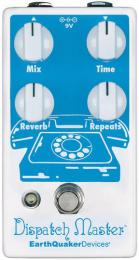
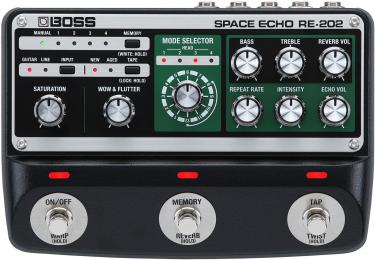
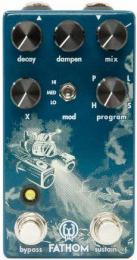
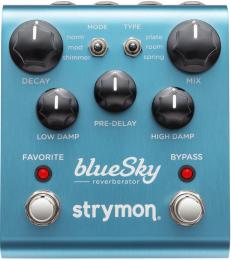
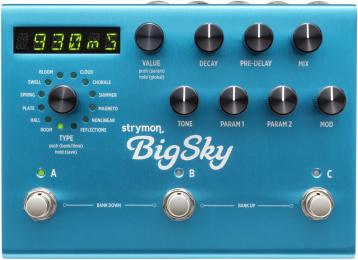
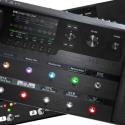
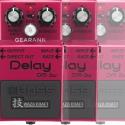
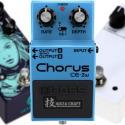
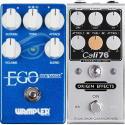
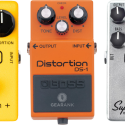
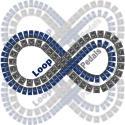
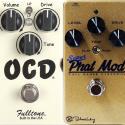
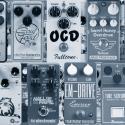
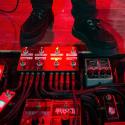
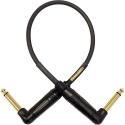





Comments
No Source Audio Collider?!
Submitted by Tom Poynton (not verified) on
No Source Audio Collider?!
Hi Tom,
Submitted by Alexander Briones on
Hi Tom,
The Source Audio Collider was previously featured, but was outranked. You can read more about the Source Audio Collider pedal here.
Publication of our September
Submitted by Jason Horton on
Publication of our September 2022 Edition resulted in the following pedals coming off our recommended list:
We have removed the
Submitted by Jason Horton on
We have removed the Earthquaker Devices Disaster Transport SR due to it being discontinued by the manufacturer.
Our March 2021 update
Submitted by Jason Horton on
Our March 2021 update resulted in the following pedals being removed from the recommended list above, but you can still see our analysis of them:
For the updated June 2020
Submitted by Jason Horton on
For the updated June 2020 edition, the following came off the recommended list above, but you can still see our analysis of them:
As a result of the October
Submitted by Jason Horton on
As a result of the October 2018 update, the following reverb pedals were removed from the recommended list above but you can still read our analysis of them here:
What about Fox Pedal's Wave
Submitted by Mike (not verified) on
What about Fox Pedal's Wave or Magnifica Deluxe?
The selection criteria for
Submitted by Jason Horton on
We only allow Reverb or Dual Reverb/Delay pedals in this guide and the Foxpedal Wave has reverb, delay and modulation effects making it ineligible.
The Foxpedal Magnifica Deluxe looks promising but we didn't find the reviews we needed to publish a rating for it so we couldn't recommend it at this stage, but it's on the short-list to be considered when we next update this guide.
Today we removed the Boss FRV
Submitted by Jason Horton on
Today we removed the Boss FRV-1 63 Fender Reverb Pedal from the recommended list above due to a lack of availability. You can still read what we have to say about it at: Boss FRV-1 63 Fender Reverb.
Great roundup! I think the
Submitted by Mark (not verified) on
Great roundup! I think the Hall of Fame is superb for the money.